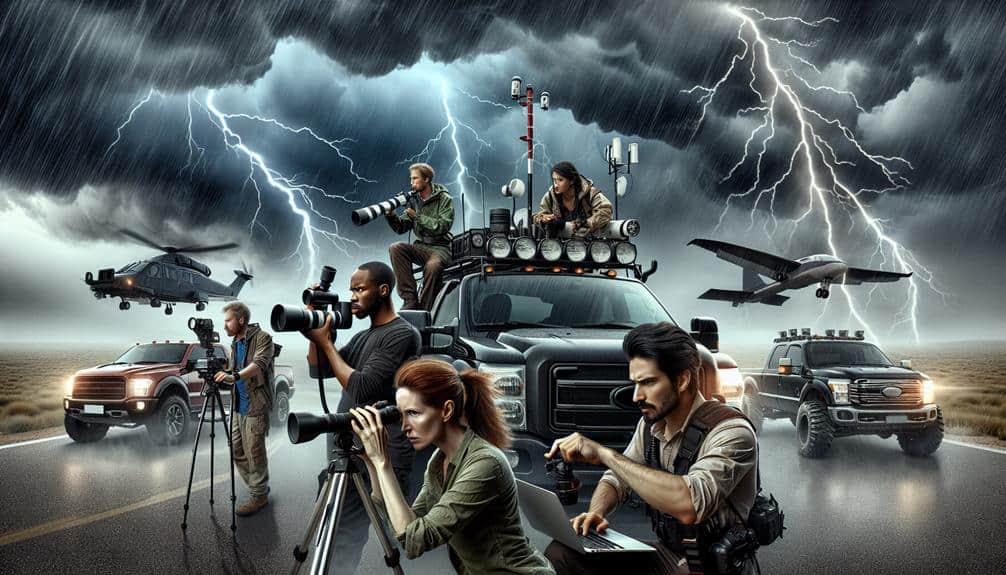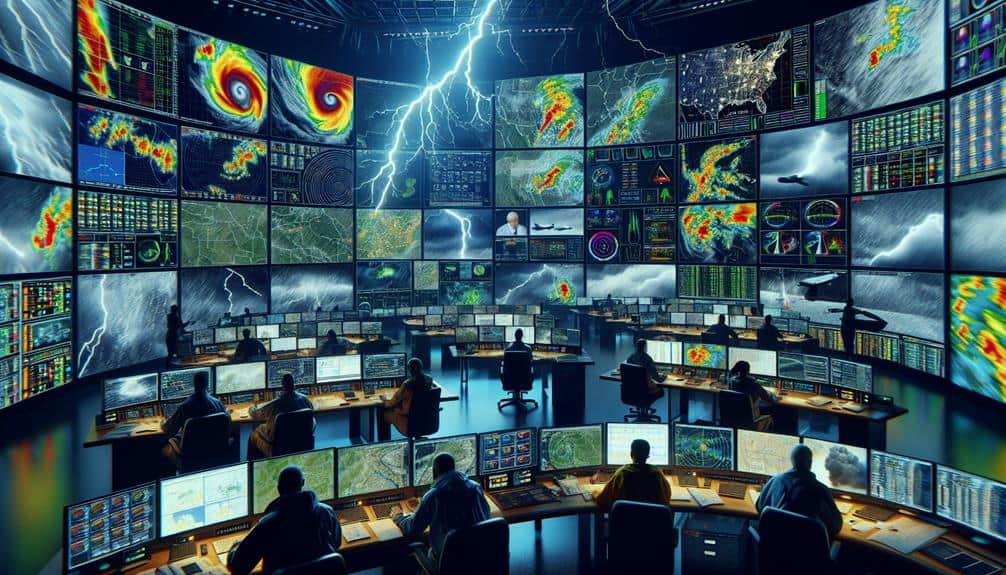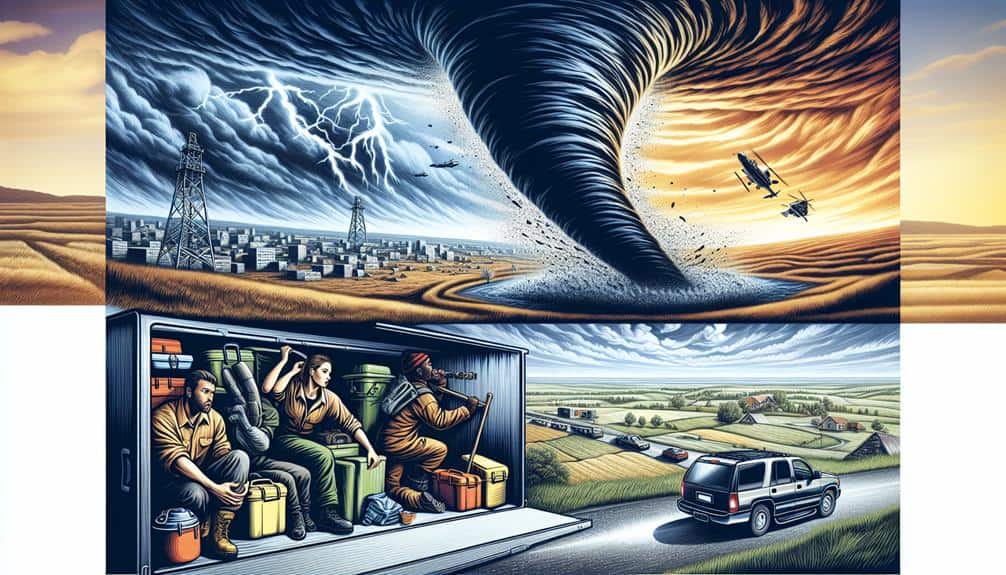We've identified the top storm chaser groups in our area, including local storm chasers, regional chase teams, and community spotting networks. They utilize advanced meteorological tools like Doppler radar, satellite imagery, and ground-based observations for precise storm tracking. These groups share real-time data, use state-of-the-art communication tools, and emphasize rigorous volunteer spotter training programs for weather safety and advanced techniques. Additionally, amateur weather observers and online chaser communities enhance their tracking capabilities with collaborative efforts. Continue on to discover detailed insights into each group and their technologies, fostering a safer storm tracking environment.
Key Points
- Advanced Meteorological Tools: Top groups use Doppler radar, satellite imagery, and real-time data for precise storm tracking.
- Community Spotting Networks: These networks share real-time insights and coordinate emergency responses using local communication channels.
- Professional Expertise: Experienced local chasers and professional groups employ cutting-edge technology for accurate monitoring and situational awareness.
- Volunteer Training Programs: Rigorous training ensures spotters are knowledgeable in weather safety and advanced storm tracking techniques.
Local Storm Chasers
In our region, numerous storm chaser groups utilize advanced meteorological tools and real-time data to monitor and document severe weather events. We frequently organize storm chaser meetups where enthusiasts and professionals alike gather to share insights, experiences, and the latest advancements in storm tracking technology.
These meetups often precede local storm chasing events, providing an invaluable opportunity to strategize and coordinate before heading into the field.
Effective storm chasing requires strict adherence to safety protocols and the use of specialized gear essentials. High-resolution radar systems, GPS units, and anemometers are just a few of the tools we rely on for accurate data collection. Personal protective equipment, such as helmets and reinforced clothing, is mandatory to safeguard against potential hazards like flying debris and extreme weather conditions.
We emphasize storm chasing safety by conducting thorough risk assessments and establishing clear communication channels. This guarantees we can react swiftly to any changes in weather patterns, thereby minimizing risk while maximizing the opportunity to capture critical data.
Community Spotting Networks
When we examine Community Spotting Networks, we focus on the efficacy of local communication channels and the critical role of volunteer spotter training.
Data shows that well-coordinated networks enhance real-time weather monitoring accuracy.
Let's analyze how these elements synergize to improve storm detection and public safety.
Local Communication Channels
Effective storm chaser groups utilize local communication channels such as community spotting networks to share real-time weather data and coordinate tracking efforts. By leveraging these networks, we enhance our ability to respond swiftly and accurately during severe weather events. Local communication channels provide a dynamic platform for disseminating critical information about storm movements, intensity, and potential hazards. This enables us to implement emergency response measures efficiently and adhere to established safety protocols, ensuring both our safety and that of the broader community.
Community spotting networks are indispensable in maintaining a well-coordinated response to evolving weather conditions. Utilizing advanced technologies like mobile apps, radio frequencies, and dedicated online platforms, we can transmit and receive data instantaneously. This continuous flow of information allows us to stay ahead of rapidly changing weather patterns and make informed decisions in real-time. These networks also facilitate collaboration between storm chasers, meteorologists, and emergency services, creating a robust, interconnected system dedicated to public safety.
Volunteer Spotter Training
How do we ensure that our volunteer spotters are equipped with the necessary skills and knowledge to accurately observe and report severe weather phenomena?
We implement rigorous, data-driven training programs focused on weather safety and advanced spotter techniques. Our training modules cover the technical aspects of weather patterns, storm structures, and the vital indicators of severe weather events, such as tornadoes, hail, and flash floods.
We emphasize hands-on experience and real-time data analysis, ensuring our spotters can make precise observations and reliable reports. Our curriculum includes the latest radar interpretation tools, cloud formation identification, and standardized reporting protocols. By simulating various severe weather scenarios, we prepare our volunteers to respond swiftly and safely.
Weather safety is paramount. We teach our spotters the importance of maintaining a safe distance from storm systems and understanding the risks associated with different weather phenomena. This knowledge is essential for both their safety and the accuracy of their reports.
Our community spotting networks thrive on the collective expertise of trained volunteers. By equipping them with in-depth training and technical skills, we empower our spotters to contribute valuable, life-saving data while exercising their freedom to explore and document nature's most powerful forces.
Regional Chase Teams

Let's examine the role of experienced local storm chasers and community-based weather enthusiasts in regional chase teams. These groups leverage their in-depth knowledge of local meteorological patterns and topography to track severe weather events with high precision.
Experienced Local Storm Chasers
Local pursuit teams, composed of experienced indigenous storm chasers, use advanced meteorological tools and real-time data to track severe weather patterns with precision. We prioritize storm chasing safety by equipping our vehicles with state-of-the-art instruments, including Doppler radar, anemometers, and GPS systems. This equipment enables us to forecast weather patterns accurately and make informed decisions on the move.
Our expertise in interpreting complex atmospheric data allows us to anticipate tornado formations, supercell developments, and other severe weather phenomena. By analyzing variables such as wind shear, barometric pressure, and humidity levels, we can predict storm behavior and potential paths. This predictive capability is vital in ensuring our safety and the safety of those we aim to inform.
Moreover, we rely on communication tools like HAM radios and satellite phones to stay connected with other storm chasers and emergency services. This networked approach enhances our situational awareness and response times.
We don't just chase storms; we document and analyze them, contributing valuable data to meteorological research and public safety initiatives. Our commitment to safety, precision, and data integrity makes local pursuit teams indispensable in the field of storm chasing.
Community-Based Weather Enthusiasts
Community-based weather enthusiasts, often organized into regional chase teams, meticulously gather and analyze meteorological data to enhance public awareness and preparedness during severe weather events. We employ advanced storm tracking strategies, leveraging Doppler radar, satellite imagery, and ground-level observations to predict storm paths and intensities with high accuracy. Our commitment to scientific rigor guarantees that the data we collect is both reliable and actionable.
One of our key activities involves weather photography, which not only documents severe weather phenomena but also aids in real-time analysis and post-event assessments. High-resolution images captured by our team provide invaluable visual data that complements the numerical and graphical outputs from meteorological instruments. This multidisciplinary approach allows us to deliver detailed weather reports that empower our communities.
We believe in the freedom to explore and understand nature's most powerful forces while prioritizing safety and public service. By sharing our findings through social media, local news outlets, and community meetings, we enhance communal knowledge and readiness. Our proactive dissemination of storm data and preparedness tips helps mitigate the risks associated with severe weather, ultimately safeguarding lives and property.
Amateur Weather Observers
In our region, numerous novice weather observers diligently gather and analyze meteorological data, contributing valuable insights to storm chaser groups. Utilizing advanced weather monitoring instruments, these enthusiasts meticulously track atmospheric parameters such as temperature, humidity, wind speed, and barometric pressure. Their commitment to precision and data accuracy can't be overstated.
During extreme conditions, such as severe thunderstorms or tornado outbreaks, amateur weather observers play an important role. Equipped with portable anemometers, barometers, and Doppler radar software, they often provide real-time updates that are essential for storm chaser groups planning their routes. This grassroots network of observers ensures that no significant weather event goes unnoticed, thereby enhancing the overall storm tracking and predictive capabilities.
We rely heavily on the data gathered by amateur observers for early warnings and to refine our predictive models. Their on-the-ground reports, often supplemented by photographs and videos, offer a detailed view of weather phenomena that satellites and official weather stations might miss.
Professional Storm Groups
Professional storm groups, equipped with state-of-the-art meteorological instruments and advanced analytic software, provide crucial and highly accurate data essential for predicting severe weather events. These groups leverage cutting-edge storm tracking technology to monitor atmospheric conditions in real-time, enabling precise predictions and timely alerts.
Our teams employ sophisticated chasing techniques, combining radar data, satellite imagery, and ground-based observations to track storm paths with unparalleled accuracy. This data-driven approach allows us to anticipate shifts in weather patterns, providing essential information that enhances public safety and preparedness.
Safety protocols are paramount in our operations. We rigorously train our members in emergency response procedures, ensuring they can navigate hazardous environments while minimizing risk. Our vehicles are outfitted with reinforced structures, communication systems, and first-aid supplies to maximize safety during storm chases.
Online Chaser Communities
Online chaser communities leverage digital platforms to share real-time data, exchange meteorological insights, and coordinate storm tracking efforts. By utilizing advanced tools like radar apps, GPS tracking, and chat forums, we can access a wealth of information instantly. This immediate data exchange not only enhances our forecasting accuracy but also fosters strong community engagement.
In these online forums, we discuss storm patterns, share high-resolution satellite images, and even live-stream our chases. This collaborative environment amplifies our collective knowledge, allowing us to predict storm behaviors more accurately.
However, we can't overlook online safety. It's vital to make sure that our data sharing doesn't compromise personal information. Using encrypted platforms and secure login methods helps safeguard our identities while we chase.
Moreover, the sense of community in these online groups is unparalleled. We connect with like-minded individuals who share our passion for meteorology and thrill-seeking. This collective enthusiasm drives us to participate more actively, attend virtual meetups, and even plan coordinated chases. Through these interactions, we not only gain technical insights but also build lasting relationships, enriching our storm chasing experience.
Frequently Asked Questions
How Do Storm Chasers Stay Safe During Severe Weather Events?
Sailing through a storm is like threading a needle. We follow strict safety protocols, constantly monitor weather data, and identify emergency shelters. By balancing thrill with caution, we secure our freedom to chase another day.
What Equipment Do Storm Chasers Typically Use?
We rely on specialized chase vehicles equipped with weather instruments like anemometers, barometers, and radar systems. These tools allow us to gather precise data and navigate severe weather conditions safely, ensuring accurate predictions and analysis.
Are There Any Age Restrictions for Becoming a Storm Chaser?
There aren't strict age restrictions for becoming a storm chaser. However, safety measures and training requirements are essential. We must guarantee proper training and follow safety protocols to minimize risks associated with extreme weather phenomena.
Can Storm Chasers Make a Living From Their Activities?
Yes, storm chasers can make a living, but income potential varies. Job opportunities exist in research and media. We must account for risks involved and adhere to strict safety precautions to guarantee our data-driven endeavors remain viable.
How Can the Public Get Involved in Storm Chasing Safely?
We can safely get involved in storm chasing by following safety tips and undergoing proper training. Through community outreach and education, we guarantee that our passion for freedom doesn't turn into a reckless dance with danger.


